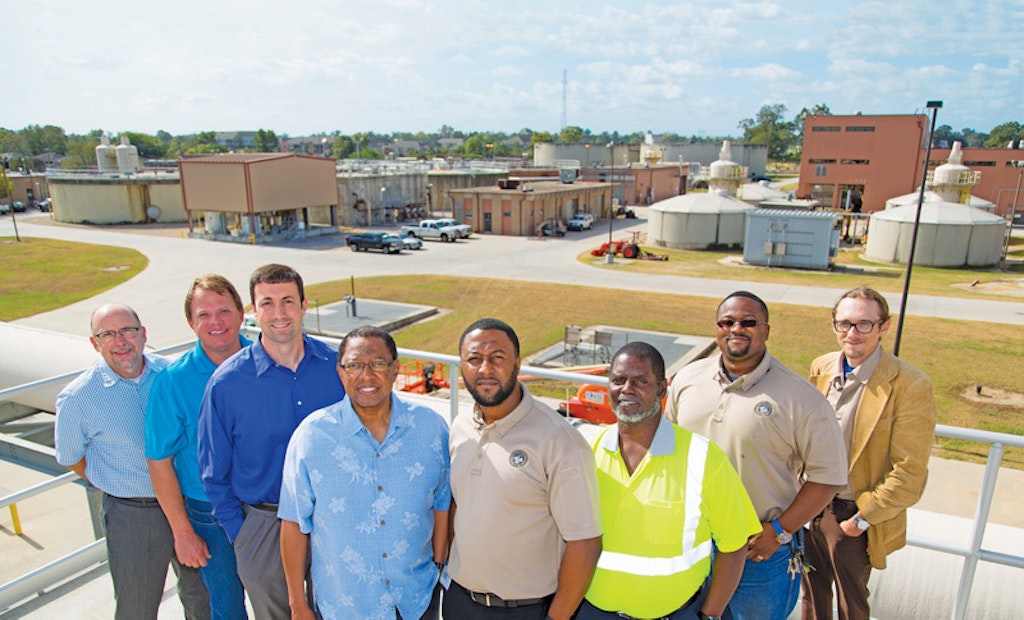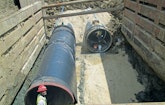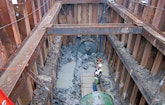
Interested in Education/Training?
Get Education/Training articles, news and videos right in your inbox! Sign up now.
Education/Training + Get AlertsBurying $1.5 billion is a tough sell. But in Baton Rouge, Louisiana, it’s forming the foundation for growth and improvement.
The money is being used to address the city’s sanitary sewer overflow problem, but it’s also making an impact on broader revitalization efforts. Baton Rouge has grown significantly over the past decade, but its SSO problems stretch back almost to the beginning of its municipal collections system.
“We started out with a bunch of package plants in various subdivisions, and then in the ‘80s we converted over to a consolidated sewer system,” says Adam Smith, interim director of the city’s Department of Environmental Services. “Going from the package plants to the consolidated system with the three treatment plants, we still had a lot of SSOs.”
Undersized mains and I&I were equal contributors to the city’s significant SSO problem. Baton Rouge is very flat geographically, so the city relies on roughly 500 pump stations to convey wastewater from an equal number of separate basins. But as subdivisions grew, volume in many areas grew beyond what the pump stations could handle. As that repeated from one basin to the next, the SSO problem multiplied.
Those SSO problems led to a consent decree with the EPA and Department of Justice in 2002.
Identifying and prioritizing
In 2005, the city brought on CH2M as the program manager. They developed a plan around rehabilitating and upgrading the city’s existing infrastructure.
“Under a previous administration we were looking into a different type of system,” says Smith, a native of Baton Rouge who worked on the SSO program for six years in a consulting role before joining DES in 2014. “They were going to create a deep tunnel system with all flow entering one gravity network to the south treatment plant. But due to constructability issues stemming from high groundwater tables, they determined that wasn’t the way to go.”
Construction of various projects started in 2009. While CH2M put the overall SSO program together, the EPA dictated the initial focus with a set of immediate action plans. “We addressed those as soon as we could, and we also developed a hydraulic model of the entire system and fine-tuned it based on population projections,” Smith says.
The hydraulic model was made more important by hurricanes Rita and Katrina, but not in the way you might expect. The city saw a huge influx of people from New Orleans and the surrounding area, and almost overnight the city had somewhere between 100,000 and 200,000 additional residents. The instant growth, and the potential for more, prompted planners to base the hydraulic model around the projected population in 2032 to ensure adequate capacity.
“The hydraulic model was fine-tuned based on those projections,” Smith says. “Wherever we saw SSOs or huge capacity problems in the model, we compared it to real-world data and developed projects based on that hydraulic model. So we ended up with about 110 projects as part of the program.”
Population growth led to similar issues on the streets side. When current mayor Kip Holden came into office in 2005, he focused on two initiatives: the SSO program and a $750 million street improvement program.
The two programs have been coordinated where possible. The SSO program is also aligned as much as possible with the general road rehab program to take advantage of opportunities to save time, money and hassle.
“That has been a huge coordination effort that has gone real well,” says John Snow, vice president of Emergent Method, a Louisiana-based management consulting firm working with DES on a number of outreach and engagement initiatives. “In a lot of cases we have installed force mains as part of the Green Light Program, so that the area was only disturbed once instead of twice.”
CH2M is managing the SSO program, and local engineering firm CSRS is managing the Green Light Program. They are responsible for coordinating with each other to make everything as efficient as possible.
For the most part, the city has been able to stick to the original Program Delivery Plan. Treatment plant projects changed to some extent due to cost and a lack of competition among contractors for that specific project, with only two bidders seeking the $50 million project. In response, the city broke it into smaller projects to stimulate interest and give more contractors an opportunity.
“We were rather fortunate in that early on when the program first started, especially from around 2009 to 2011, we had a lot of out-of-state contractors coming in,” says Smith.
“We’ve also got a pretty good group of local contractors who have continued to bid on our work. While some of the out-of-state contractors have gone back to their hometowns, the local guys have remained here and remained competitive.”
Small-business engagement has been a big focus of the program, and Smith says CH2M has done a good job of letting people know about upcoming projects, and encouraging local contractors and suppliers.
“I think having that be a strong point of emphasis with our mayor and the metro council all the way down to project teams has really helped the economy,” Snow adds. “You have two of the largest capital improvement programs that have ever been undertaken at the local level here going on along parallel tracks. You’re going to need a lot of capabilities and expertise, and the leadership here — and frankly everyone at the city — has been very intentional about trying to engage local contractors and local firms whenever possible. I think both the SSO program and the transportation program have done a very good job with that.”
Footing the bill
Engaging a large pool of contractors has helped with competitive bidding, but funding a $1.6 billion program is still a challenge.
“We’ve got various bonds,” Smith says. “We’ve got some EPA monies, and then we’ve got a half-cent sales tax that’s for sewer as well, and then we have user fees. So we have various forms of funding.”
A four-year extension on the consent decree was also beneficial in stretching out payments and allowing the utility to generate more of its own funding rather than bonding for everything. The original deadline set in the consent decree was Dec. 31, 2014, but that was extended to December 2018.
Smith says everything is on track to complete the SSO program on time. Approximately 75 percent of the SSO program work is already complete. The last capacity jobs were bid out in October, and all the remaining projects under the program were bid out by the end of 2016.
Seeing results
Smith says that while the impact of the SSO program is obvious, inaccuracies with historic SSO data make it difficult to provide exact numbers on how much SSOs have been reduced.
“We weren’t recording SSOs the way we should have been,” Smith says. “A lot of them weren’t being captured by the guys in the field, so unfortunately right now, we’re only comfortable with a little over a year’s worth of data.
“I can’t sit here and say we reduced our SSOs by X percent, but what I can tell you is, there are areas where we knowingly had SSOs every time it rained, but once we put those projects online those SSOs went away. I think that’s been the most telling for us, that as we see projects come online we see those wet weather SSOs go away. On a project-specific basis, we can show drastic improvement.”
The results of the program are being felt in other ways, too.
“When you look at the dollars that went back into the engineering and construction community, I think it has had a huge impact on the local economy,” Smith says.
In addition to both the direct and indirect economic impact, Snow says there are obvious health, environmental and quality-of-life improvements.
“It’s pretty straightforward when you look at it,” he says. “An investment like this is made to ensure a sustainable foundation from which you can both grow and sustain yourself as a community. So investments like these in such an intentional and programmatic way are essentially how communities continue to thrive and grow.”
Baton Rouge has seen tremendous growth in the downtown area over the past 10-plus years. Snow points out that with a major capital improvement project like the SSO program going on at the same time, it’s critical that planners and officials make sure those initiatives are supporting one another.
“We certainly want investments like these to continue catalyzing growth in areas that are rife for it or are currently undergoing revitalization,” Snow says. “First and foremost you don’t want to hinder that growth, but if you’re investing in infrastructure like this, you want to make sure you’re doing everything you can to ensure that you’re keeping pace with that growth. I think through this program and others, we’ve done that.”
Pumping through the storm
Baton Rouge wasn’t affected greatly by hurricanes Katrina and Rita, at least from a storm damage perspective. Hurricane Gustav in 2009 was a different story.
“At one point during the storm the entire parish was out of power. That significantly affected our system,” says Adam Smith, interim director of the city’s Department of Environmental Services. “Another thing that this administration did that has proved to be one of the best decisions ever in my opinion was, following that, the mayor said we are going to have backup generators at every pump station in the parish. We were in the process of negotiating a time extension with the EPA. So we said we’re going to ask for this time extension, but we’re also going to add to the work that we’re going to commit to, and we’re going to put backup generators at every pump station.”
In August 2016, historic flooding caused an estimated at $8.7 billion in damage across the state. Some areas around Baton Rouge received over 2 feet of rain.
Ninety of the city’s pump stations were damaged. Some had 4 to 6 feet of water in them, which damaged electrical components. Damage totaled about $5 million, but through it all, the city’s collections system kept functioning.
“With the flood that we just had, that decision proved to be very wise and helped us tremendously,” Smith says. “I don’t want to think about trying to make it through a hurricane without all those generators.”










